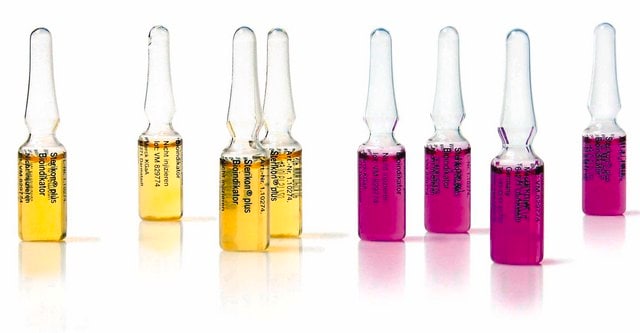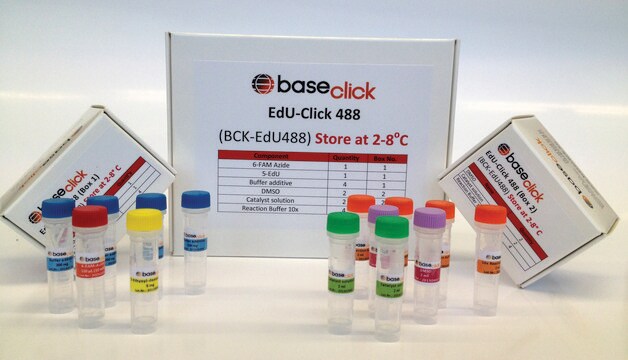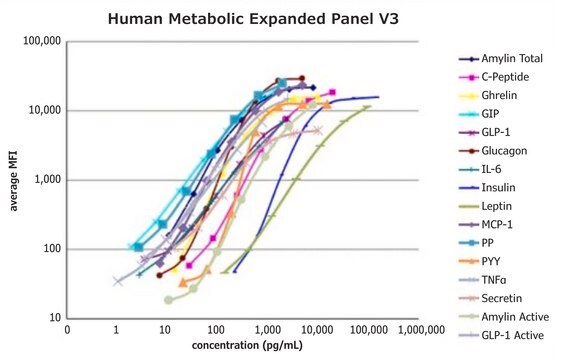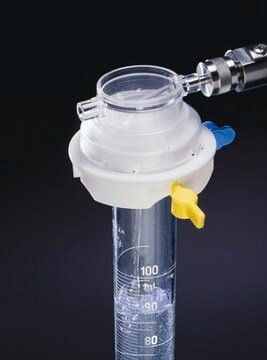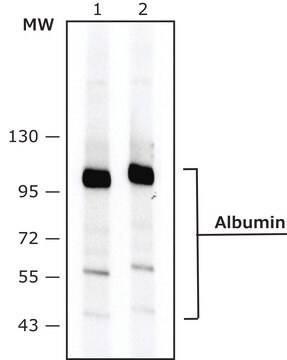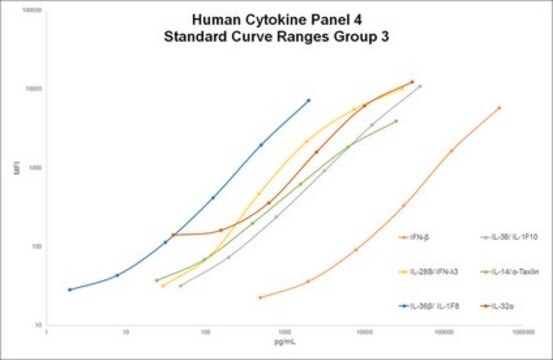EZHMWAN-65K
Human High Molecular Weight (HMW) Adiponectin ELISA
About This Item
Empfohlene Produkte
Qualität
for protein analysis
Qualitätsniveau
Beschreibung
analytes available: Adiponectin
1.56-200 ng/mL (standard curve range; see specific lot information)
Leistungsmerkmale
accuracy 98-110%
Speziesreaktivität
human
Messbereich Sensitivität
1.5 ng/mL
Methode(n)
ELISA: suitable
UniProt-Hinterlegungsnummer
Nachweisverfahren
colorimetric
fluorometric
Allgemeine Beschreibung
SIZE: 244 amino acids; 26414 Da
SUBUNIT: Homomultimer. Forms trimers, hexamers and 12- to 18-mers. The trimers (low molecular weight complexes / LMW) are assembled via non-covalent interactions of the collagen-like domains in a triple helix and hydrophobic interactions within the globular C1q domain. Several trimers can associate to form disulfide-linked hexamers (middle molecular weight complexes / MMW) and larger complexes (higher molecular weight / HMW). The HMW-complex assembly may rely aditionnally on lysine hydroxylation and glycosylation. LMW, MMW and HMW complexes bind to HBEGF, MMW and HMW complexes bind to PDGFB, and HMW complex binds to FGF2.
SUBCELLULAR LOCATION: Secreted.
TISSUE SPECIFICITY: Synthesized exclusively by adipocytes and secreted into plasma.DOMAIN:SwissProt: Q15848 The C1q domain is commonly called the globular domain.
PTM: Hydroxylated Lys-33 was not identified in PubMed:16497731, probably due to poor representation of the N-terminal peptide in mass fingerprinting. & HMW complexes are more extensively glycosylated than smaller oligomers. Hydroxylation and glycosylation of the lysine residues within the collagene-like domain of adiponectin seem to be critically involved in regulating the formation and/or secretion of HMW complexes and consequently contribute to the insulin- sensitizing activity of adiponectin in hepatocytes (By similarity). & O-linked glycans consist of Glc-Gal disaccharides bound to the oxygen atom of post-translationally added hydroxyl groups. & Not N-glycosylated.
DISEASE: SwissProt: Q15848 # Defects in ADIPOQ are the cause of adiponectin deficiency [MIM:605441]. The result is a very low concentration of plasma adiponectin. Decreased adiponectin plasma levels are associated with obesity insulin resistance, and diabetes type 2.
SIMILARITY: Contains 1 C1q domain. & Contains 1 collagen-like domain.
MISCELLANEOUS: Variants Arg-84 and Ser-90 show impaired formation of HMW complexes whereas variants Cys-112 and Thr-164 show impaired secretion of adiponectin in any form. & HMW-complex blood contents are higher in females than in males, are increased in males by castration and decreased again upon subsequent testosterone treatment, which blocks HMW- complex secretion (By similarity). In type 2 diabetic patients, both the ratios of HMW to total adiponectin and the degree of adiponectin glycosylation are significantly decreased as compared with healthy controls.
Anwendung
Hinweis zur Analyse
Haftungsausschluss
Signalwort
Danger
Gefahreneinstufungen
Acute Tox. 3 Dermal - Acute Tox. 4 Inhalation - Acute Tox. 4 Oral - Aquatic Chronic 3 - Eye Dam. 1 - Met. Corr. 1 - Resp. Sens. 1 - Skin Irrit. 2 - Skin Sens. 1 - STOT RE 2
Zielorgane
Respiratory Tract
Lagerklassenschlüssel
6.1C - Combustible, acute toxic Cat.3 / toxic compounds or compounds which causing chronic effects
WGK
WGK 3
Analysenzertifikate (COA)
Suchen Sie nach Analysenzertifikate (COA), indem Sie die Lot-/Chargennummer des Produkts eingeben. Lot- und Chargennummern sind auf dem Produktetikett hinter den Wörtern ‘Lot’ oder ‘Batch’ (Lot oder Charge) zu finden.
Besitzen Sie dieses Produkt bereits?
In der Dokumentenbibliothek finden Sie die Dokumentation zu den Produkten, die Sie kürzlich erworben haben.
Unser Team von Wissenschaftlern verfügt über Erfahrung in allen Forschungsbereichen einschließlich Life Science, Materialwissenschaften, chemischer Synthese, Chromatographie, Analytik und vielen mehr..
Setzen Sie sich mit dem technischen Dienst in Verbindung.